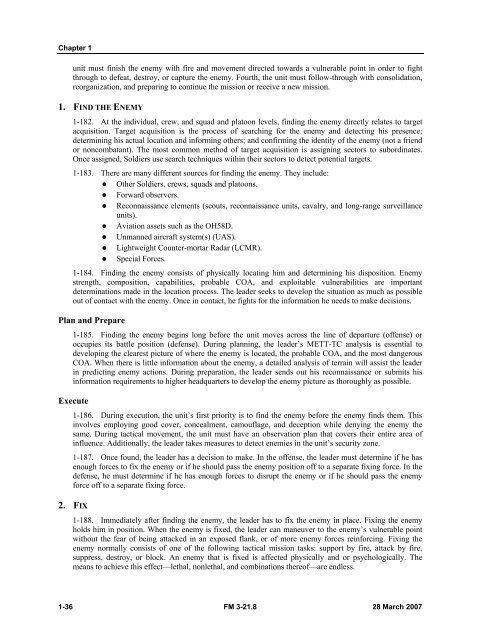Infantry Rifle Platoon and Squad - Sakai
Infantry Rifle Platoon and Squad - Sakai
Infantry Rifle Platoon and Squad - Sakai
You also want an ePaper? Increase the reach of your titles
YUMPU automatically turns print PDFs into web optimized ePapers that Google loves.
Chapter 1<br />
unit must finish the enemy with fire <strong>and</strong> movement directed towards a vulnerable point in order to fight<br />
through to defeat, destroy, or capture the enemy. Fourth, the unit must follow-through with consolidation,<br />
reorganization, <strong>and</strong> preparing to continue the mission or receive a new mission.<br />
1. FIND THE ENEMY<br />
1-182. At the individual, crew, <strong>and</strong> squad <strong>and</strong> platoon levels, finding the enemy directly relates to target<br />
acquisition. Target acquisition is the process of searching for the enemy <strong>and</strong> detecting his presence;<br />
determining his actual location <strong>and</strong> informing others; <strong>and</strong> confirming the identity of the enemy (not a friend<br />
or noncombatant). The most common method of target acquisition is assigning sectors to subordinates.<br />
Once assigned, Soldiers use search techniques within their sectors to detect potential targets.<br />
1-183. There are many different sources for finding the enemy. They include:<br />
• Other Soldiers, crews, squads <strong>and</strong> platoons.<br />
• Forward observers.<br />
• Reconnaissance elements (scouts, reconnaissance units, cavalry, <strong>and</strong> long-range surveillance<br />
units).<br />
• Aviation assets such as the OH58D.<br />
• Unmanned aircraft system(s) (UAS).<br />
• Lightweight Counter-mortar Radar (LCMR).<br />
• Special Forces.<br />
1-184. Finding the enemy consists of physically locating him <strong>and</strong> determining his disposition. Enemy<br />
strength, composition, capabilities, probable COA, <strong>and</strong> exploitable vulnerabilities are important<br />
determinations made in the location process. The leader seeks to develop the situation as much as possible<br />
out of contact with the enemy. Once in contact, he fights for the information he needs to make decisions.<br />
Plan <strong>and</strong> Prepare<br />
1-185. Finding the enemy begins long before the unit moves across the line of departure (offense) or<br />
occupies its battle position (defense). During planning, the leader’s METT-TC analysis is essential to<br />
developing the clearest picture of where the enemy is located, the probable COA, <strong>and</strong> the most dangerous<br />
COA. When there is little information about the enemy, a detailed analysis of terrain will assist the leader<br />
in predicting enemy actions. During preparation, the leader sends out his reconnaissance or submits his<br />
information requirements to higher headquarters to develop the enemy picture as thoroughly as possible.<br />
Execute<br />
1-186. During execution, the unit’s first priority is to find the enemy before the enemy finds them. This<br />
involves employing good cover, concealment, camouflage, <strong>and</strong> deception while denying the enemy the<br />
same. During tactical movement, the unit must have an observation plan that covers their entire area of<br />
influence. Additionally, the leader takes measures to detect enemies in the unit’s security zone.<br />
1-187. Once found, the leader has a decision to make. In the offense, the leader must determine if he has<br />
enough forces to fix the enemy or if he should pass the enemy position off to a separate fixing force. In the<br />
defense, he must determine if he has enough forces to disrupt the enemy or if he should pass the enemy<br />
force off to a separate fixing force.<br />
2. FIX<br />
1-188. Immediately after finding the enemy, the leader has to fix the enemy in place. Fixing the enemy<br />
holds him in position. When the enemy is fixed, the leader can maneuver to the enemy’s vulnerable point<br />
without the fear of being attacked in an exposed flank, or of more enemy forces reinforcing. Fixing the<br />
enemy normally consists of one of the following tactical mission tasks: support by fire, attack by fire,<br />
suppress, destroy, or block. An enemy that is fixed is affected physically <strong>and</strong> or psychologically. The<br />
means to achieve this effect—lethal, nonlethal, <strong>and</strong> combinations thereof—are endless.<br />
1-36 FM 3-21.8 28 March 2007

















